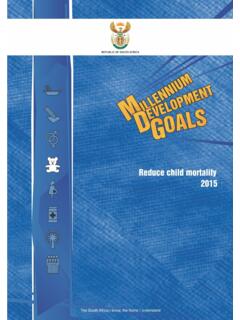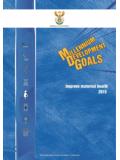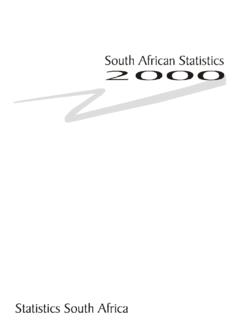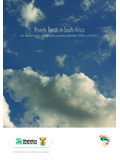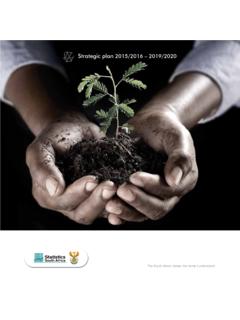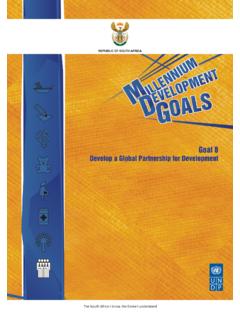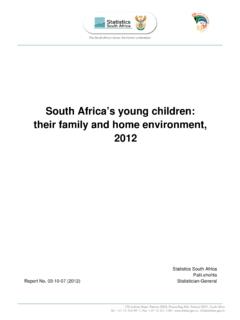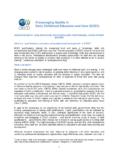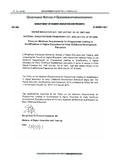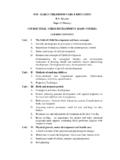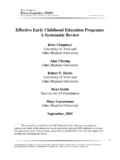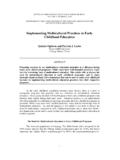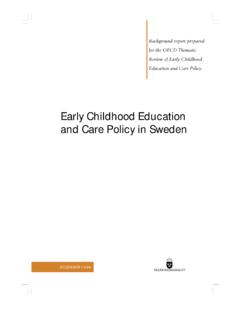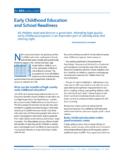Transcription of Education Series Volume iv Early childhood development in ...
1 Risenga MalulekeStatistician-GeneralStatistics South AfricaEducation Series Volume ivEarly childhood development in South Africa, 2016 Our children are the rock on which our future will be built, our greatest asset as a nationNelson Mandela (3 June 1995)The National Integrated Policy for Early childhood development (2015)The National Plan for Action in South Africa (2012-2017)The National development Plan: Vision for 2030 National legal and operational child related frameworkNational plans related to ECDI nternational agreements and protocols The South African Constitution The Children s Act (Act No. 38 of 2005)South African Schools Act (Act No. 84 of 1996) Maintenance Act (Act No. 99 of 1998)Social Assistance Act (Act No.)
2 13 of 2004) The African Charter on the Rights and Welfare of the Child (RSA ratified 2000) The United Nations Declaration on Human RightsThe United Nations Conventions on the Rights of the Child and associated protocols (RSA ratified 1995)Sustainable development GoalsContext154236N u t r i t i o n a l S u p p o r tM a t e r n a l h e a l t hS o c i a l S e r v i c e sS u p p o r t f o r p r i m a r y c a r e-g i v e r sC h i l d h e a l t hS t i m u l a t i o n f o r e a r l y l e a r n i n gApproved by cabinet in 2015, the ECD Policy emphasises 6 essential components to promote optimal child development from conception to 9 yearsThis release illustrates the current status utilising the General Household Survey and Administrative recordsECD Policy 00,20,40,60,811,202468101214161820222426 2830323436384042444648505254565860626466 687072747678808284868890 Millions*8.
3 2 Million0-6 Year OldsMillions15%of the total population were children aged between 0-6 Age*Source: Mid year population estimates, 2016SA POPULATIONT otal SA population in 2016 : *55,9 Million* Note: Due to the differences in methodology used, mid-year population estimates are higher than population estimates produced from household surveys 34%35%25%23%37%40%4%3%Age 0 Age 1 Age 2 Age 3 Age 4 Age 5 Age 6 PercentageTraditionalFormal Urban NonMetroFormal Urban MetroFarmGeographic Location4 out of 7 young children lived in urban areas Source: GHS, 2016 Children aged 0-6 by level of overcrowding, 2016LP24%MP25%KZN37%EC45%FS33%NW38%NC40% WC37%GP26%By Population GroupColoured: 38%Black African: 35%White: 9%Indian/Asian: 6%* Overcrowding: more than two persons-per-room in a dwelling regardless of the size of the dwelling : GHS, 201684%86%86%89%90%90%91%94%97%ECKZNGPWC FSNWMPNCLPRSA Average at 88,6 %Households connected to the mains Children aged 0 6 in households connected to the mains electricity supply by province, 201635%46%57%67%72%78%87%89%94%010203040 5060708090100 ECLPKZNNWRSAMPNCFSWCGPRSA Average at 67,2%Households with children aged 0-6 by main source of water Households with children aged 0-6 by main source of water (piped water in dwelling/on site) and province, 2016 Source.
4 GHS, 201657,2%66,8%73,7%78,2%82,3%87,3%91,5%9 3,0%95,8%LPMPNWKZNRSAFSNCECGPWCH ouseholds with children aged 0-6 with access to improved sanitation, 2016 Nearly 8 children out of 10 (81,4%) aged 0 6 had access to * improved Average at 81,4%* Flush-toilets connected to public sewerage; flush-toilets connected to a septic tank; pit latrine/toilet with ventilation pipe; and ecological sanitation systems are recognised as better improved sanitation in terms of the criteria Source: GHS, 2016 Source: South Africa s young children: their family and home environment, 2012 Marital Status of Fathers and MothersNumber of children aged 0 6 living with their biological parents, 2016 With MotherWith BothWith NeitherWith Father12%46%40%2%Source: GHS, 201649%39%8%11%35%53%89%86%14%6%4%2%0%50 %100%Black AfricanColouredIndian/AsianWhiteNumber of children aged 0 6 living with their biological parents by Population group 2016 With FatherWith NeitherWith MotherWith BothSource.
5 GHS, 2016 One thirdof large (more than 6 members) households with young children aged 0-6 did not have a single employed memberMain source of household income:Salaries:51%Grants: 34%Other income:7%Remittance: 7%Pension: 1%None: 0%Source: GHS, 2016 Children aged 0-6 by the number of employed household members and main source of income, 201622%13%4%2%24%16%5%9%18%24%13%13%21%1 9%10%11%15%28%67%66%0,010,020,030,040,05 0,060,070,080,090,0100,0 Black AfricanColouredIndian/AsianWhiteLowest income quintileQuintile 2 Quintile 3 Quintile 4 Highest income quintileLarge household income inequalities by population groupSource: GHS, 2016 Children aged 0-6 by monthly household income quintile and population group, 2016 Early childhood nutrition, child and maternal healthN u t r i t i o n a l S u p p o r t72,6%31,1%5,0%1,3%Aged 0 Aged 1 Aged 2 Aged 3 Aged 4 Aged 5 Aged 6 0,0 10,0 20,0 30,0 40,0 50,0 60,0 70,0 80,0 90,0 100,0 Source: GHS, 2016 Nutritional Support: Children who are still breastfed by age, 201673% of babies less than one year were still breastfed.
6 32% were exclusively breastfed21,4%21,5%21,9%22,9%24,8%27,4%2 8,5%33,5%34,2%0102030 NCMPLPWCECNWKZNFSGPH eight-for-age (stunted)3,4%3,8%4,7%4,9%5,8%8,0%8,4%11, 9%12,6%051015 ECKZNMPLPGPFSNCWCNWW eight-for-age (underweight)Nutritional Support: Stunting, Underweight and WastingAround a third of children in GP and the FS were stunted, NW had the highest rates of Wasting and Underweight childrenSource: SADHS, 20160,5%1,3%1,5%1,7%2,1%2,5%4,1%4,6%5,9% 0246 MPGPECWCNCKZNLPFSNWW eight-for-height (wasted)Figures for weight-for height for the WC was based on 25-49 unweighted cases. Nutritional Support: Stunting, Underweight and WastingFigures for weight-for height for the WC was based on 25-49 unweighted West and Western Cape have the highest percentage of children who are underweight;12,6% and 11,9% compared to other provincesStuntingUnderweightWastingNorth West, Free State and Limpopo have the highest percentage of children who are wasted; 5,9%, 4,6% and 4,1% compared to other provincesSource: SADHS ,2016 Figures for weight-for height for the WC was based on 25-49 unweighted ; 49%MP; 54%38%NC52%NW; 44%2631364146512013201648%FS; 47%45%WC.
7 46%26313641465120132016 Nutritional Support: Vitamin A dose 12-59 months coverage Deficit in vitamin Ain infants may cause blindness and make infants susceptible to infections and to life-threatening illnessesSource: DHIS 2016GP21,1%25,5%17,3%01020304050 RSAF emale headed householdsMale headed householdsPast 12 months35,7%36,8%34,3%01020304050 RSAF emale headed householdsMale headed households5 days or more in past 30 daysFemale headed households were more likely to have members of the household who skipped a mealPercentage of households with children aged 0-6 who skipped any meal by gender of the household head, 2016 Source: GHS, 201615,3%17,4%22,1%16,3%0,05,010,015,020 ,025,0 UrbanTraditionalFarmRSAP ercentageOne of the main implications of the integrated ECD policy in South Africa is its emphasis on child nutrition starting from the wombNationally 16,3%of pregnant women stayed in households where members experienced hungerSource: GHS, 2016 Nutritional Support: Pregnant women, aged 12-50 who stayed in households where members experienced hunger by settlement type (2016)93%76%61%0,020,040,060,080,0100,0 Antenatal women on ARTM other postnatal visit within 6 daysFirst antenatal visit before 20 weeksPercentageSource.
8 DHIS, 2016 Antenatal and postnatal care for pregnant women, 2015-2016 The MTSF seeks to achieve higher targets by 201970% by 201980% by 201998% by 20192019 MTSF Targets2016 Status71 Under 5 mortality rate4448 Infant mortality rate340,010,020,030,040,050,060,070,080, 0200220032004200520062007200820092010201 120122013201420152016201720182019 Deaths per 1 000 live births Deaths/Births per 1 000 peopleChild Health: Under 5 and Infant Mortality RatesIn spite of the progress achieved in child survival both the UMR and the IMR were still very high by developed countries standard The MTSF targetsunder 5 mortality rate at 33 per 1000 livebirths by 2019 Source: Mid-year population estimates, 2016 The MTSF targets infant mortality rate at 23 per 1000 livebirths by 201911,4%10,0%8,3%4,5%4,0%3,9%3,5%2,7%1, 8%1,8%1,7%1,6%9.
9 1%Respiratory and cardiovascular disorders infectious diseasesInfluenza and pneumoniaMalnutritionDisorders related to length of gestation and disorders originating in the perinatal periodInfections specific to the perinatal periodFetus and newborn affected by maternal malformations of the circulatory systemOther acute lower respiratory infectionsOther viral diseasesOther bacterial diseasesOther natural causesNon-natural causesThe common underlying cause of death amongst young children was respiratory and cardiovascular disorders specific to the perinatal period35,8%Source: Causes of death, 2015 The underlying causes of deaths (aged 0 6), 2015 Immunisation coverage for children aged 12 -23 months,2016LP67%MP56%KZN62%EC71%FS80%NW5 6%NC75%WC68%GP52%Source: SADHS, 2016 The lowest percentage of full immunisation was achieved in Gauteng 52%61% in 201663% in Services and ECD InterventionsS o c i a l S e r v i c e s57%65%66%69%73%76%79%81%85%95%ECKZNRSAN WFSGPMPWCLPNCEC is significantly below the SA average for delivery in facilitySocial Services: Delivery in health facility rate, 2016 Source.
10 DHIS, 20162 out of3births took place at health facilities11,5%6,2%5,0%0,02,04,06,08,010 ,012,014,016,018,020,0012 PercentageAgeChildren aged 0-2 with or without birth certificates, 2016 Overall, 7,5% of young children aged 0-2 did not have birth certificatesBy age two 34,9% of those that did not receive a birth certificate indicated they had still not : GHS, 201611704895575737975435532680020 00040 00060 00080 000100 000120 000140 00020112012201320142015 Extent of late birth registration, 2011-2015 Source: Recorded live Births, 2016late birth registrationNumber of crimes committed against children 18 years and younger and conviction rate, 2015/2016 MurderAttempted murderSexual offencesComplaints reportedComplaints in courtConvictions90620 2548841 83524875812820 0483 007 Sexual offences were the largest crime committed against childrenSource: SAPS, 2015/2016*Data for age bracket 0 6 only was not available for analysisPercentage of grant recipients children aged 0-6 by province, 2017LP89%MP72%KZN73%EC77%FS80%NW66%NC80% WC54%GP52%Source.
